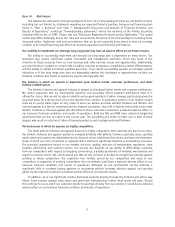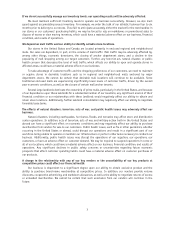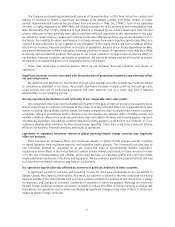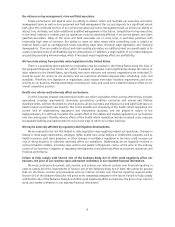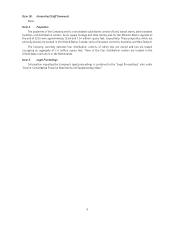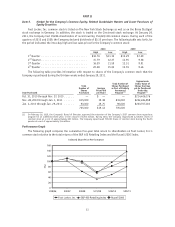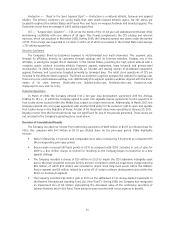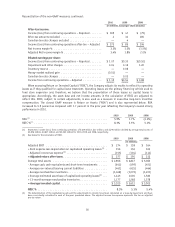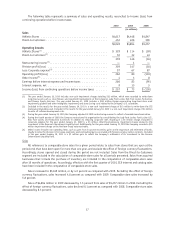Foot Locker 2010 Annual Report Download - page 26
Download and view the complete annual report
Please find page 26 of the 2010 Foot Locker annual report below. You can navigate through the pages in the report by either clicking on the pages listed below, or by using the keyword search tool below to find specific information within the annual report.In addition, our products are subject to import and excise duties and/or sales or value-added taxes in many
jurisdictions. Fluctuations in tax rates and duties and changes in tax legislation or regulation could have a
material adverse effect on our results of operations and financial condition.
Complications in our distribution centers and other factors affecting the distribution of merchandise may
affect our business.
We operate four distribution centers worldwide to support our businesses. In addition to the distribution
centers that we operate, we have third-party arrangements to support our operations in the U.S., Canada,
Australia, and New Zealand. If complications arise with any facility or any facility is severely damaged or
destroyed, the Company’s other distribution centers may not be able to support the resulting additional
distribution demands. This may adversely affect our ability to deliver inventory on a timely basis. We depend
upon third-party carriers for shipment of a significant amount of merchandise. An interruption in service by these
carriers for any reason could cause temporary disruptions in our business, a loss of sales and profits, and other
material adverse effects.
Our freight cost is affected by changes in fuel prices through surcharges. Increases in fuel prices and
surcharges and other factors may increase freight costs and thereby increase our cost of sales. We enter into
diesel fuel forward and option contracts to mitigate a portion of the risk associated with the variability caused by
these surcharges.
A major failure of our information systems could harm our business.
We depend on information systems to process transactions, manage inventory, operate our websites,
purchase, sell and ship goods on a timely basis, and maintain cost-efficient operations. Any material disruption or
slowdown of our systems could cause information to be lost or delayed, which could have a negative effect on our
business. We may experience operational problems with our information systems as a result of system failures,
viruses, computer ‘‘hackers’’ or other causes. We cannot be assured that our systems will be adequate to support
future growth.
Risks associated with Internet operations.
Our Internet operations are subject to numerous risks, including risks related to the failure of the computer
systems that operate our websites and their related support systems, including computer viruses,
telecommunications failures and similar disruptions. Also, we may require additional capital in the future to
sustain or grow our online commerce.
Business risks related to online commerce include risks associated with the need to keep pace with rapid
technological change, Internet security risks, risks of system failure or inadequacy, governmental regulation and
legal uncertainties with respect to the Internet, and collection of sales or other taxes by additional states or
foreign jurisdictions. If any of these risks materializes, it could have a material adverse effect on the Company’s
business.
Unauthorized disclosure of sensitive or confidential customer information, whether through a breach of the
Company’s computer systems or otherwise, could severely harm our business.
As part of the Company’s normal course of business, it collects, processes, and retains sensitive and
confidential customer information. Despite the security measures the Company has in place, its facilities and
systems, and those of its third party providers may be vulnerable to security breaches, acts of vandalism,
computer viruses, misplaced or lost data, programming and/or human error, or other similar events. Any security
breach involving the misappropriation, loss or other unauthorized disclosure of confidential information by the
Company could severely damage its reputation, expose it to the risks of litigation and liability, disrupt its
operations and harm its business.
7







